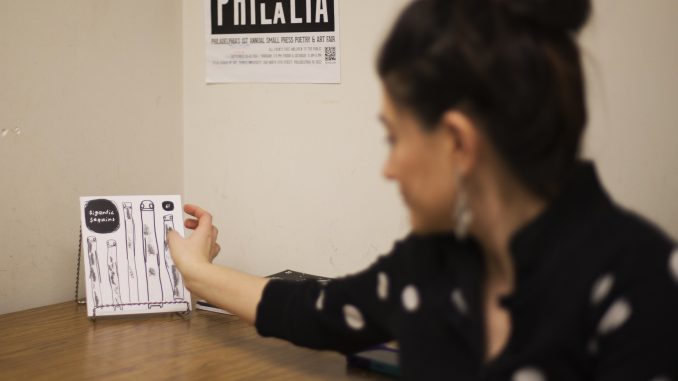
Monochromatic blends of poetry, art, fiction and nonfiction share the same home. Between the 6-by-7-inch paper fold, Gigantic Sequins fashions a literary world.
Gigantic Sequins, a literary arts journal, is published twice annually across the nation. Gigantic Sequins searches for pieces that contribute to a diversified construct.
“I look for things that are a bit more surreal or have a heightened level of reality,” Zach Yontz, Gigantic Sequins fiction editor, said in an email.
As a photographer, Yontz said he uses his different perspectives as an asset for his work.
“I’m looking for something that sort of gets at my heart/brain in a visceral way,” Yontz said in an email. “It is just a wonderful thing to put these strange, beautiful stories into the world and surround them with all of this other wonderful art.”
Yontz joined the Gigantic Sequins team after a personal publication in the 1.2 issue and a reading in Boston.
“From there it was just a rocket ship, straight to the stars,” Yontz said. The photographer took the opportunities presented by Kimberly Ann Southwick, editor-in-chief and founder of Gigantic Sequins, to become a member of the staff.
Southwick, also an adjunct professor, began Gigantic Sequins with a staff of four in New York City. Southwick, Shereen Adel, Daniel Christensen and Paul Medina produced the beginnings of the 6-year-old journal.
“We like stuff that does with language something that hasn’t been done previously,” Southwick said, “And at the same time, moves us in a way.”
“There’s so much good art out there that’s in color and there is probably just as much good art that’s just in black and white and we like – I like – showcasing that,” Southwick said.
She clutched her cup of tea as loose strands of hair fell from her messy bun, a pencil ensnared between the tresses.
“There’s just so much great black and white art out there, why not?” she said.
As a reader, Southwick said she explores different genres and time periods to vary her tastes.
“I think that helps diversify what I like and makes me more open to something,” she said. “I think our personalities come out in what we choose but at the same time I only hire editors that can’t not want to publish anything because they like a very specific thing.”
“We all work surprisingly close together considering we are literally thousands of miles apart at any given time,” Yontz said. “Everyone has their strengths when it comes to making Gigantic Sequins work.”
Currently a nonprofit publication, Southwick strives to pay the volunteer writers and artists of Gigantic Sequins by 2016.
“I would love to be financially sustainable without having to rely on donations and contest fees,” Southwick said.
“It’s ‘a labor of love,’ we like to call it,” she said. Twice a year, the official meetings are held informally through video chat. All the staff members let their personalities pixelate between time zones and disregard formalities.
“Making all of our distance and asynchronous schedules and weird habits come together to create our journal twice a year is a super rewarding experience and I’ve been able to meet deeply interesting people who are just so in love with creating and sharing art,” Yontz said.
There is not a singular message to be drawn from Gigantic Sequins. Southwick said although print publications have been described as declining due to the digital age, she sees value in the physical work her team produces.
“Print isn’t dead and it can be beautiful,” she said.
Yontz shared similar beliefs to Southwick in a comical light.
“To have it in this little black-and-white square where it is a tangible, physical thing and not as ephemeral as some things on the Internet can be,” Yontz said, “I guess the message is that I am a 90-year-old man who likes holding books.”
Allison Merchant can be reached at allison.merchant@temple.edu.



Be the first to comment